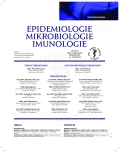The possibilities for the implementation of whole genome sequencing (WGS) of Neisseria meningitidis in molecular surveillance of invasive meningococcal disease in the Czech Republic
Authors:
Z. Vacková; P. Křížová; Z. Jandová; M. Musílek; J. Kozáková
Authors‘ workplace:
Centrum epidemiologie a mikrobiologie, Státní zdravotní ústav, Praha
Published in:
Epidemiol. Mikrobiol. Imunol. 66, 2017, č. 1, s. 50-52
Category:
Short Communication
Overview
The implementation of the surveillance of invasive meningococcal disease is recommended worldwide. The Whole Genome Sequencing (WGS) method increasingly comes to the fore, which provides the possibilities for further detailed characterization of Neisseria meningitidis and makes it possible to integrate all conventional sequencing approaches into one method. Six N. meningitidis isolates from 2013 and 2015, characterized previously by Sanger amplicon sequencing, were selected to be studied by the novel WGS method. WGS data analysis has confirmed the accuracy of this method in determining epidemiological markers. The aim of this communication is to point out the possibility for the implementation of WGS into molecular surveillance of invasive meningococcal disease in the Czech Republic. The National Reference Laboratory for Meningococcal Infections (NRL/MEN) will continue to use WGS for molecular characterization of selected isolates of N. meningitidis and for the improvement of molecular surveillance of invasive meningococcal disease in the country.
KEYWORDS:
whole genome sequencing – WGS – Neisseria meningitides – molecular surveillance
Sources
1. European Centre for Disease Prevention and Control. Expert opinion on whole genome sequencing for public health surveillance. Stockholm: ECDC; 2016; s. 1–14. ISBN 978-92-9193-888-9.
2. Maiden MC, Bygraves JA, Feil E, et al. Multilocus sequence typing: a portable approach to the identification of clones within populations of pathogenic microorganisms. Proc Natl Acad Sci USA, 1998;95 : 3140–3145.
3. Jandová Z, Musílek M, Vacková Z, et al. Klonální analýza populace meningokoky z invazivního onemocnění a od zdravých nosičů izolovaných v České republice v období 1971–2014 (květen). Epidemiol Mikrobiol Imunol, 2015;64(3):147–152.
4. Hill DM, Lucidarme J, Gray SJ, et al. Genomic epidemiology of age-associated meningococcal lineages in national surveillance: an observational cohort study. Lancet Infect Dis, 2015;15(12):1420–1428. doi: 10.1016/S1473-3099(15)00267-4. Epub 2015 Oct 27.
5. Jolley KA, Maiden MCJ. Using MLST to study bacterial variation: prospects in the genomic era. Future Microbiol, 2014;9(5):623–630.
6. Jolley KA, Maiden MCJ. BIGSdb: Scalable analysis of bacterial genome variation at the population level. BMC Bioinformatics, 2010;11 : 595.
7. Jolley KA, Maiden MCJ. Automated extraction of typing information for bacterial pathogens from whole genome sequence data: Neisseria meningitidis as an exemplar. Euro Surveill, 2013;18(4):20379.
8. Jolley KA, Hill DM, Bratcher HB, et al. Resolution of a meningococcal disease outbreak from whole-genome sequence data with rapid Web-based analysis methods. J Clin Microbiol, 2012;50 : 3046–3053.
9. Maiden MC, Jansen van Rensburg MJ, Bray JE, et al. MLST revisited: the gene-by-gene approach to bacterial genomics. Nat Rev Microbiol, 2013;11(10):728–736.
10. Křížová P, Musílek M, Vacková Z, et al. Sekvenční analýza antigenů zařazených v čtyřkomponentní vakcíně proti meningokoku B v Českých izolátech Neisseria meningitidis v období 2007–20013. Epidemiol Mikrobiol Imunol, 2014;63(1):61–68.
Labels
Hygiene and epidemiology Medical virology Clinical microbiologyArticle was published in
Epidemiology, Microbiology, Immunology

2017 Issue 1
Most read in this issue
- Management of acute anaphylaxis in clinical practice in the context of the guidelines
- The prevalence of antibodies against Hepatitis E Virus in the Czech Republic: serological survey
- Foodborne botulism – a re-emerging public health challenge
- Infectious diseases and laboratory diagnosisin the Terezin Jewish Ghetto
